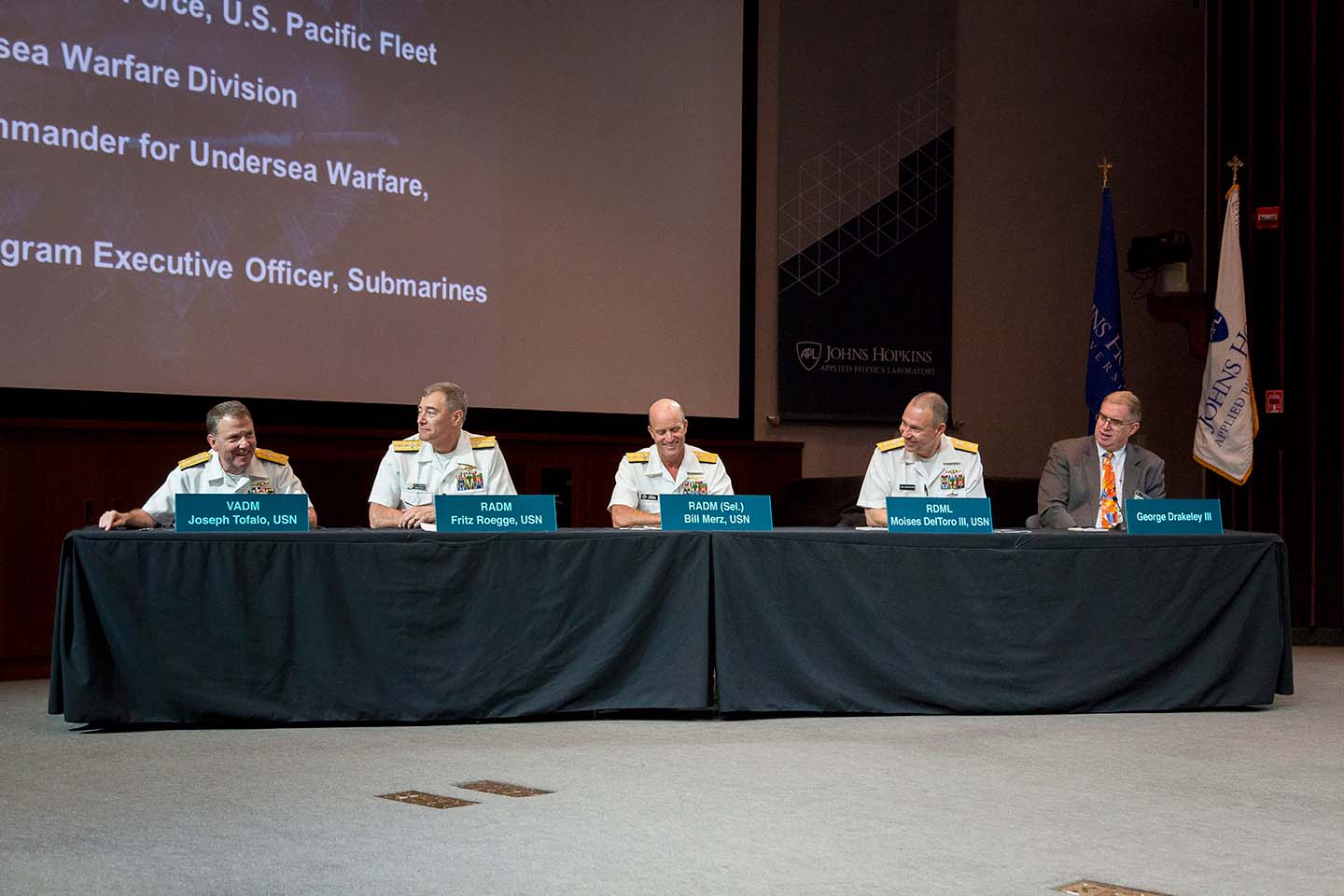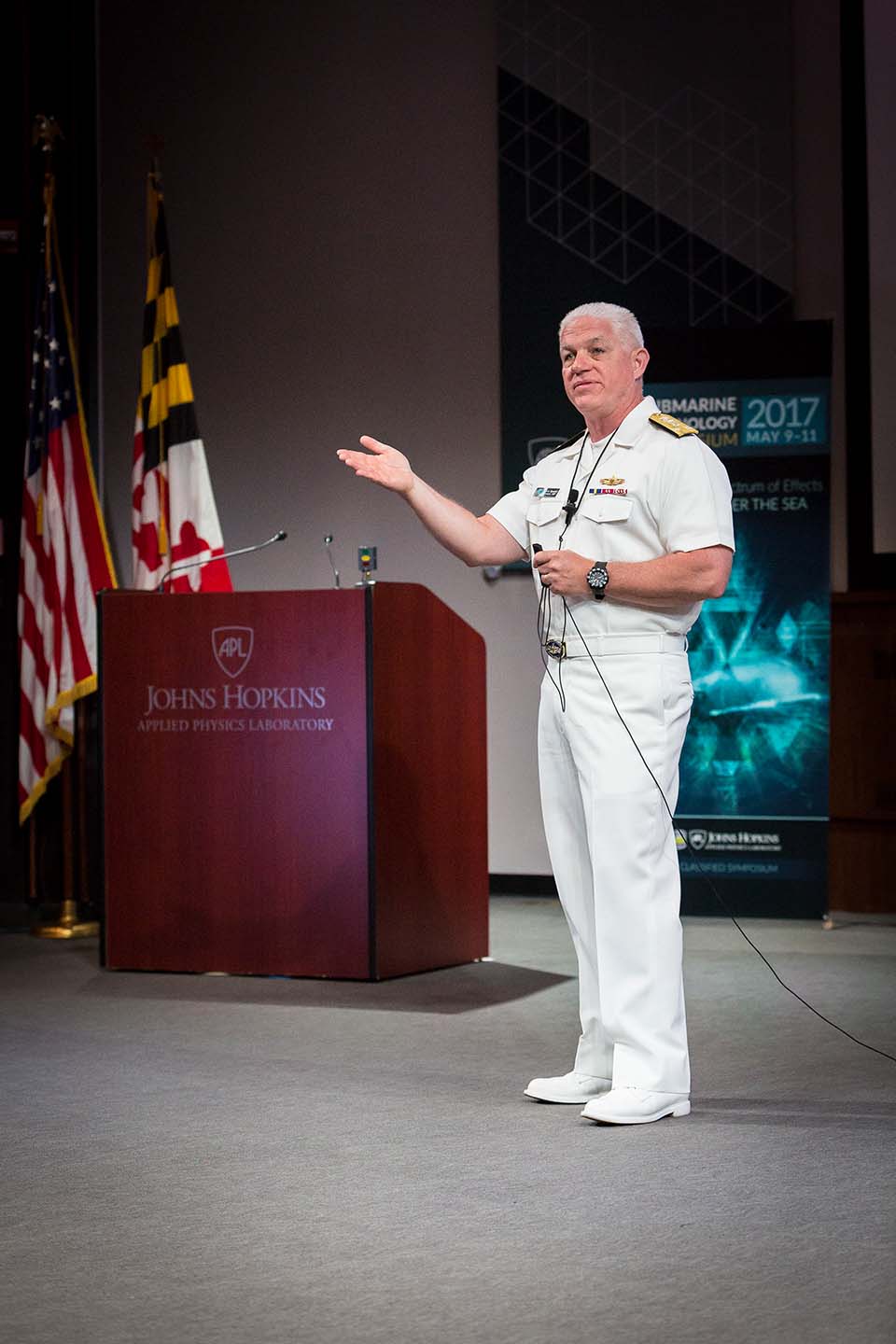
From left, Vice Adm. Joseph Tofalo, Rear Adm. Fritz Roegge, Rear Adm. (Sel) Bill Merz, Rear Adm. Moises Deltoro III, and George Drakeley III take part in a roundtable discussion.
Credit: APL
Press Release
29th SubTech Symposium Focuses on Undersea Challenges and Innovative Solutions
Since its inception nearly three decades ago, the Submarine Technology Symposium — co-hosted by the Johns Hopkins Applied Physics Laboratory and the Naval Submarine League — has served as a prime platform for collaboration, addressing technology challenges that affect the future of the undersea domain.
A capacity audience of approximately 500 attendees gathered in APL’s Kossiakoff Center on its Laurel, Maryland, campus over three days in May. The attendees learned about and discussed innovative and critical technologies that have the potential to further undersea capabilities and mission execution.
In its 29th year, STS focused on a theme of “Delivering a Spectrum of Effects from Under the Sea.” According to the 2015 Commander’s Intent, Submarine Forces, undersea assets enjoy key attributes — stealth, technological advancement, highly trained crews — that “permit operational, deterrent and combat effects that the Navy and the nation could not otherwise achieve ... These effects may be delivered within the undersea domain or across domain boundaries; they may be delivered from submarines far-forward or in broad ocean areas; they may be the result of carefully coordinated operations with other forces or achieved by independent operations; and they may be accomplished in peacetime, a time of tension or during conflict.”
The vision for this year’s STS was to focus on the advances necessary to meet this challenging Commander’s Intent; namely, to enable discussion of innovative and critical technologies that expand undersea capabilities to achieve missions across this spectrum of effects, with specific emphasis given to the technology’s relationship to the mission. Addressing this helped inform the undersea community regarding the move to domain effects from advanced platform capabilities, advanced payloads and off-board systems.
“Each year, we strive to put together this truly unique opportunity for those in the submarine force and undersea warfare community,” said Lisa Blodgett, head of APL’s Force Projection Sector. “Attendees hear from Submarine Force leadership, Fleet speakers and subject-matter experts to learn both about operational challenges and about the latest undersea technology advancements. The venue includes technical presentations, hands-on exhibits and opportunities for networking discussions.”

Credit: APL
The conference kicked off on May 9 with opening remarks by retired Navy Admiral Kirk Donald, Chairman of the Board, Naval Submarine League, followed by a keynote from Vice Adm. Joseph Tofalo, Commander, Submarine Forces. Additional keynote speakers during the symposium included Submarine Force leaders Rear Adm. Fritz Roegge, Commander, Submarine Force, Pacific Fleet; Rear Adm. (Sel.) Bill Merz, Director, Undersea Warfare Division; Vice Adm. Terry Benedict, Director, Strategic Systems Programs; Vice Adm. James Foggo III, Director, Navy Staff; Vice Adm. Rick Breckenridge, Deputy Commander, U.S. Fleet Forces Command; Rear Adm. Michael Jabaley, Program Executive Officer, Submarines; and Ron O’Rourke, Specialist in Naval Affairs in the Congressional Research Service.
Industry, research, academic, government and military speakers contributed to daily sessions covering a variety of topics, specifically Seabed Warfare, Vital Intelligence, Undersea Based Deterrence, Sea Control and Effects Ashore.
The technical session on Seabed Warfare, led by session chair Pierre Corriveau and assistant session chair Louis DiPalma, both of Raytheon, focused on technologies and future concepts that expand U.S. ability to exploit seabed topography, infrastructure and obscurity as well as adversary technologies that may challenge that mission.
Session chair Dave Pistacchio and assistant session chair George Zvara of the Naval Undersea Warfare Center led a technical session on Vital Intelligence. Technical papers were presented on technologies, future concepts and processing innovations that improve submarine intelligence collection and expand the exquisite understanding of the adversary and battlespace, along with technologies that may present potential challenges to this mission.
Session chair Bob Bacon and assistant session chair Alex Edsall, both of Charles Stark Draper Laboratory, led the Undersea Based Deterrence technical session. Covered during the session were papers discussing technologies, future concepts and concepts of operations that capitalize on undersea advantages to provide a survivable strategic deterrent and a robust conventional capability to deter both nuclear and conventional conflict and adversary technologies that may present potential challenges to this mission.
The Sea Control technical session was coordinated by session chair Giles Gibson and assistant session chair Justin Morrison of APL. It included four technical papers related to innovative technologies to improve submarine search, detection, classification, approach and engagement of adversary submarines and surface ships. Session participants also discussed the need to enhance protection of sea lines of communications and maneuvering space and denial of same to the enemy, in addition to adversary technologies that may present challenges to this mission.
The final technical session of the conference was Effects Ashore, led by session chair Karl Hasslinger and assistant session chair Jennifer Panosky, of General Dynamics Electric Boat. Papers were presented on innovative technologies that improve submarine operations and mission execution in shallow water and close proximity to land.
Attendees also heard from various Fleet representatives — including Capt. Erik Burian, Director for Training, Tactical Development and Doctrine on the staff of the Commander, Submarine Force, Pacific Fleet; Capt. Rob Gaucher, Commander, Submarine Development Squadron 5; Cmdr. Dan Reiss, Commanding Officer, USS New Mexico (SSN 779); and Capt. Brian Humm, former Commander of Submarine Squadron 19 — whose presentations connected the session technology discussions to Fleet challenges and opportunities.
Attendees also had the opportunity to take in 16 exhibits during the three-day symposium. On the last day of the conference, retired Rear Adm. Charlie Young, the 2017 STS general chair, moderated a roundtable discussion with panel members Roegge; Merz; Rear Adm. Moises Deltoro III, Deputy Commander, Undersea Warfare; and George Drakeley III, Executive Director and Program Executive Officer, Submarines.
“We worked hard to create a program of diverse work, from a diverse group, with a focus on operational context and utility, to provide our attendees with the most relevant and interesting information related to the undersea domain,” said Angela Sarich, of APL, who served as symposium program chair. “We addressed the historic, core missions related to undersea operations, and presented the latest techniques and technologies that can give the Fleet the tools and systems they need to maintain our nation’s superiority.”
The authors and exhibitors at the symposium were selected by session chairs and received final approval from the executive committee led by Young, who served as chair, and Blodgett, STS co-chair.
The first STS was held in 1988 at APL, which has hosted every symposium to date. The inaugural symposium was conceived as a classified forum where technologies relevant to capabilities of submarines and related systems could be advanced and examined by experts in various technical fields. Today, STS is considered the premier technical conference on submarine-related technologies.
The 30th Submarine Technology Symposium will be held at APL on May 15–17, 2018.